List of Antillian and Bermudan animals extinct in the Holocene
This list of Antillian and Bermudan animals extinct in the Holocene features animals known to have become extinct in the last 12,000 years on the Antilles archipelago and Bermuda (collectively known as the West Indies) between North America and South America.
.svg.png.webp)
Map of the West Indies
Many extinction dates are unknown due to a lack of relevant information.
Mammals
Undated
| Common name/scientific name | Range |
|---|---|
| Insulacebus toussaintiana | Southern Haiti[1] |
| Lemke's hutia Rhizoplagiodontia lemkei |
Southern Haiti[1] |
Prehistoric
| Common name/scientific name | Extinction date | Range | Image |
|---|---|---|---|
| Lesser Puerto Rican ground sloth Acratocnus odontrigonus |
1738–1500 BCE[2] | Puerto Rico | |
| Hispaniolan ground sloth Acratocnus ye |
8540–1590 BCE[3] | Hispaniola | |
| Hispaniola monkey Antillothrix bernensis |
2035–1735 BCE[3] | Hispaniola | |
| Plate-toothed giant hutia Elasmodontomys obliquus |
511–407 BCE[4] | Puerto Rico | |
| Cayman Islands geocapromys Geocapromys caymanensis |
666-857[5] | Cayman Islands | |
| Insular cave rat Heteropsomys insulans |
772–870[4] | Puerto Rico | |
| Cuban giant sloth Megalocnus rodens |
2280–2240 BCE[6] | Cuba |  |
| Barbuda giant rice rat Megalomys audreyae |
1173–1385[2] | Barbuda | |
| Lesser Haitian ground sloth Neocnus comes |
2480–2400 BCE[3] | Hispaniola |  |
| Haiti pine forest ground sloth Neocnus dousman |
8540–1590 BCE[3] | Hispaniola | |
| Neocnus toupiti | 8540–1590 BCE[3] | Southern Haiti | |
| Puerto Rican nesophontes Nesophontes edithae |
1015–1147[4] | Puerto Rico |  |
| Cayman nesophontes Nesophontes hemicingulus |
666–857[5] | Cayman Islands | |
| Atalaye nesophontes Nesophontes hypomicrus |
1175–1295[7] | Hispaniola | |
| Greater Cuban nesophontes Nesophontes major |
7043–6507 BCE[2] | Cuba | 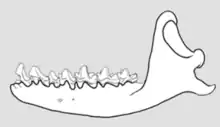 |
| Western Cuban nesophontes Nesophontes micrus |
1310–1410[3] | Cuba |  |
| St. Michel nesophontes Nesophontes paramicrus |
1265–1400[7] | Hispaniola | |
| Haitian nesophontes Nesophontes zamicrus |
1295–1430[2] | Hispaniola | |
| Giant ghost-faced bat Mormoops magna |
7043–6503 BCE[2] | Cuba | |
| Brown's ground sloth Parocnus brownii |
3290–2730 BCE[8] | Cuba | |
| Greater Haitian ground sloth Parocnus serus |
8540–1590 BCE[3] | Hispaniola |  |
| Puerto Rican flower bat Phyllonycteris major |
c. 1500 BCE[9] | Puerto Rico and Antigua | |
| Lesser falcate-winged bat Phyllops vetus |
40 BCE – 20 CE[10] | Cuba and Juventud | |
| Xaymaca fulvopulvis | 9390–8220 BCE[3] | Jamaica | |
| Jamaican monkey Xenothrix mcgregori |
439–473[11] | Jamaica |
Recent
| Common name/scientific name | Extinction date | Range | Image |
|---|---|---|---|
| Anthony's fruit-eating bat Artibeus anthonyi |
1957–1993[12] | Cuba | |
| Oriente cave rat Boromys offella |
16th century?[13] | Cuba | 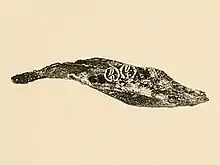 |
| Torre's cave rat Boromys torrei |
16th century?[14] | Cuba | 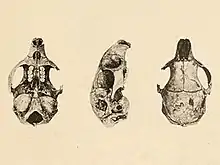 |
| Hispaniolan edible rat Brotomys voratus |
1550-1670[15] | Hispaniola | |
| Cayman Islands hutia Capromys sp. |
1525-1625[15] | Cayman Islands | |
| Cuban coney Geocapromys columbianus |
16th century?[16] | Cuba | |
| Little Swan Island hutia Geocapromys thoracatus |
early 1950s[17] | Little Swan Island, Honduras | .JPG.webp) |
| Imposter hutia Hexolobodon phenax |
16th century?[18] | Hispaniola | |
| Montane hutia Isolobodon montanus |
16th century?[19] | Hispaniola | |
| Puerto Rican hutia Isolobodon portoricensis |
1525[20] | Hispaniola and Gonâve; introduced to Puerto Rico, Mona, and U.S. Virgin Islands | |
| Martinique giant rice rat Megalomys desmarestii |
1897[21] | Martinique |  |
| Saint Lucia giant rice rat Megalomys luciae |
c. 1881[22] | Saint Lucia |  |
| Puerto Rican long-nosed bat Monophyllus plethodon frater |
1851–1900[23] | Puerto Rico | |
| Caribbean monk seal Neomonachus tropicalis |
1952[24] | Caribbean Sea, Bahamas, and Gulf of Mexico | 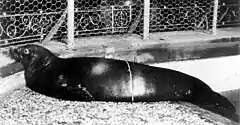 |
| Saint Vincent pygmy rice rat Oligoryzomys victus |
1892[25] | Saint Vincent | |
| Jamaican rice rat Oryzomys antillarum |
1877[26] | Jamaica |  |
| Barbados rice rat Oryzomys sp. |
before 1890[3] | Barbados | |
| Nevis rice rat Pennatomys nivalis |
1930s?[27] | Saint Kitts and Nevis and Sint Eustatius | |
| Samana hutia Plagiodontia ipnaeum |
16th century?[28] | Hispaniola | |
| Marcano's solenodon Solenodon marcanoi |
16th century?[29] | Hispaniola |
| Common name/scientific name | Extinction date | Range | Image |
|---|---|---|---|
| Dwarf hutia Mesocapromys nanus |
1951[30] | Ciénaga de Zapata, Cuba | |
| San Felipe hutia Mesocapromys sanfelipensis |
1978[31] | Key Juan García, Cuba | 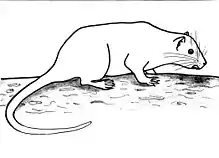 |
Local
| Common name/scientific name | Extinction date | Range | Image |
|---|---|---|---|
| Common vampire bat Desmodus rotundus |
1957–1993[12] | From Mexico and Cuba to Uruguay |  |
Birds
Undated
| Common name/scientific name | Range | Image |
|---|---|---|
| Woodward's eagle Amplibuteo woodwardi |
California to Florida and the Caribbean[32] | 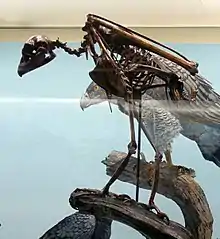 |
| Cuban flightless crane Antigone cubensis |
Cuba[32] | |
| Cuban horned owl Bubo osvaldoi |
Cuba[32] | |
| Cuban titan-hawk Buteogallus borrasi |
Cuba[32] | |
| Asphalt stork Ciconia lydekkeri |
From the United States to Argentina[32] | |
| Cuban kestrel Falco kurochkini |
Cuba[32] | |
| Gallinago kakuki | Greater Antilles[32] | |
| Suarez's giant eagle Gigantohierax suarezi |
Cuba[32] | |
| Cuban caracara Milvago carbo |
Cuba[32] | |
| Wetmore's stork Mycteria wetmorei |
Southern United States and Cuba[32] | |
| Cuban cursorial owl Ornimegalonyx oteroi |
Cuba[32] | 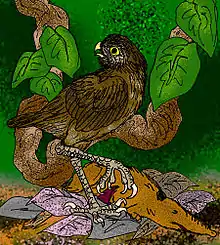 |
| Cuban teratorn Oscaravis olsoni |
Cuba[32] |
Prehistoric
| Common name/scientific name | Extinction date | Range | Image |
|---|---|---|---|
| St. Croix macaw Ara autocthones |
c. 1200–1500[33] | Saint Croix and Puerto Rico |  |
| Bahaman caracara Caracara creightoni |
700–400 BCE[34] | Cuba and Bahamas |  |
| Puerto Rican quail-dove Geotrygon larva |
after human settlement[35] | Puerto Rico |  |
| Cuban cave rail Nesotrochis picapicensis |
760[32] | Cuba | |
| Haitian cave rail Nesotrochis steganinos |
5339–5474 BCE[36] | Hispaniola | |
| Cuban spectacled owl Pulsatrix arredondoi |
530–590[32] | Cuba | |
| Hispaniola woodcock Scolopax brachycarpa |
1320–1380[37] | Hispaniola | |
| Cuban pauraque Siphonorhis daiquiri |
7043–6507 BCE[2] | Cuba | |
| Noel's barn owl Tyto noeli |
1900–1600 BCE[32] | Cuba, Jamaica, and Bermuda | |
| Jamaican ibis Xenicibis xympithecus |
787 BCE – 320 CE[2] | Jamaica | 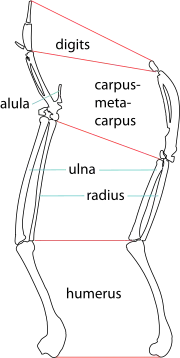 |
Recent
| Common name/scientific name | Extinction date | Range | Image |
|---|---|---|---|
| Bermuda saw-whet owl Aegolius gradyi |
1609–1610[35] | Bermuda | |
| Jamaican wood rail Amaurolimnas concolor concolor |
1881[35] | Jamaica | |
| Martinique amazon Amazona martinicana |
1779[38] | Martinique | 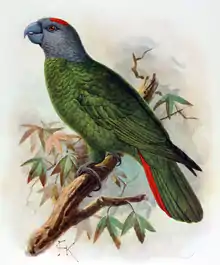 |
| Guadeloupe amazon Amazona violacea |
1779[39] | Guadeloupe | 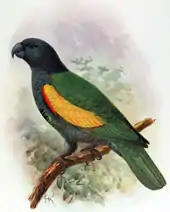 |
| Aruba amazon Amazona barbadensis canifrons |
1944–1947[35] | Aruba | 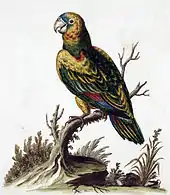 |
| Culebra Island amazon Amazona vittata gracilipes |
1899[35] | Culebra Island of Puerto Rico | |
| Lesser Antillean macaw Ara guadeloupensis |
1742[35] | Guadeloupe |  |
| Martinique macaw Ara martinicus |
17th century | Martinique (hypothetical) | |
| Cuban macaw Ara tricolor |
1889[35] | Cuba and Juventud |  |
| Antiguan burrowing owl Athene cunicularia amaura |
late 19th century[40] | Antigua and Barbuda | |
| Guadeloupe burrowing owl Athene cunicularia guadeloupensis |
late 19th century[40] | Guadeloupe | |
| Bermuda hawk Bermuteo avivorus |
1603[41] | Bermuda | |
| Dwarf thick-knee Burhinus nanus |
1460-1660[42] | Bahamas | |
| Gonâve eastern chat-tanager Calyptophilus frugivorus abbotti |
1977[35] | Gonâve Island, Haiti | |
| Samaná eastern chat-tanager Calyptophilus frugivorus frugivorus |
1982[35] | Samaná Peninsula, Dominican Republic | |
| Cuban ivory-billed woodpecker Campephilus principalis bairdii |
1987[43] | Cuba | 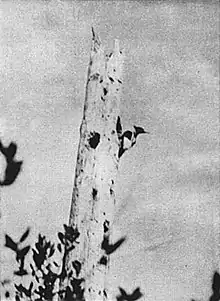 |
| Bermuda flicker Colaptes oceanicus |
1623[35] | Bermuda | |
| Virgin Islands screech owl Gymnasio nudipes newtoni |
1936[35] | Virgin Islands |  |
| Grand Cayman oriole Icterus leucopteryx bairdi |
1938[35] | Grand Cayman, Cayman Islands | |
| St. Kitts bullfinch Melopyrrha grandis |
1929[35] | Saint Kitts | 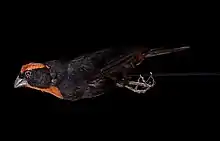 |
| Antillean cave rail Nesotrochis debooyi |
1943?[35] | Puerto Rico and the Virgin Islands |  |
| Bermuda night heron Nyctanassa carcinocatactes |
1610[44] | Bermuda | 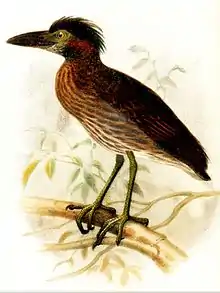 |
| Bermuda towhee Pipilio naufragus |
1609–1610[35] | Bermuda | |
| Guadeloupe parakeet Psittacara labati |
1724[35] | Guadeloupe | 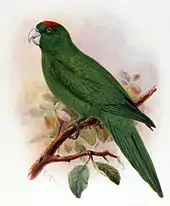 |
| Puerto Rican parakeet Psittacara maugei |
1892[35] | Puerto Rico and Mona Island | 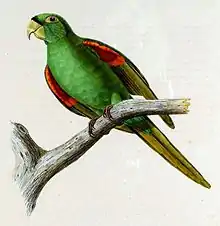 |
| Brace's emerald Riccordia bracei |
1877[45] | New Providence, Bahamas | 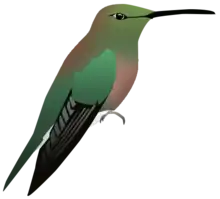 |
| Gould's emerald Riccordia elegans |
1860[46] | Jamaica? |  |
| Jamaican golden swallow Tachycineta euchrysea euchrysea |
1989[35] | Jamaica | 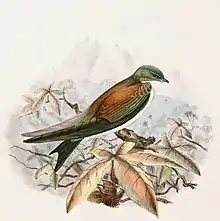 |
| Guadeloupe house wren Troglodytes aedon guadeloupensis |
1973[35] | Guadeloupe | |
| Martinique house wren Troglodytes aedon martinicensis |
1886[35] | Martinique | |
| Grand Cayman thrush Turdus ravidus |
1938[47] | Grand Cayman, Cayman Islands | |
| Hispaniolan giant barn owl Tyto ostologa |
1788?[35] | Hispaniola | |
| Bahaman giant barn owl Tyto pollens |
16th century?[35] | Cuba and Bahamas | 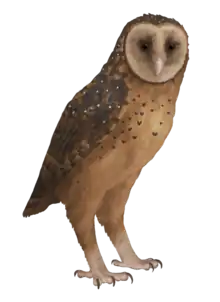 |
| Common name/scientific name | Extinction date | Range | Image |
|---|---|---|---|
| Semper's warbler Leucopeza semperi |
1961[48] | Saint Lucia mountains |  |
| Jamaican petrel Pterodroma caribbaea |
1879[35] | Jamaica, and possibly Dominica and Guadeloupe | 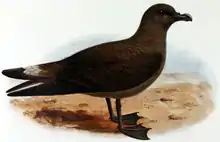 |
| Jamaican poorwill Siphonorhis americana |
1860[49] | Jamaica | 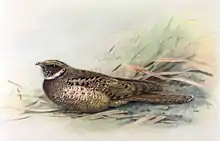 |
| Bachman's warbler Vermivora bachmanii |
1988[50] | Southeastern United States and Cuba | 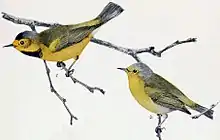 |
Local
| Common name/scientific name | Extinction date | Range | Image |
|---|---|---|---|
| Red-shouldered hawk Buteo lineatus |
Late Holocene[32] | Northeastern Mexico, eastern United States and Canada, Cuba, and Bahamas | 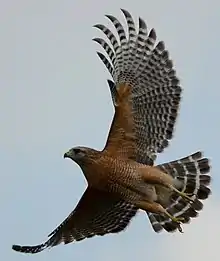 |
| Aplomado falcon Falco femoralis |
Late Holocene[32] | From New Mexico to Patagonia | 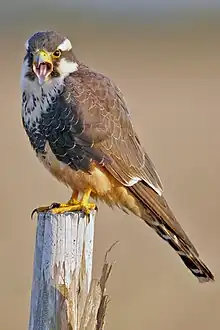 |
| Black-chested buzzard-eagle Geranoaetus melanoleucus |
Late Holocene[32] | South America and Cuba | .jpg.webp) |
| Bare-throated tiger heron Tigrisoma mexicanum |
Late Holocene[32] | Coastal Central America and Cuba |  |
Reptiles
| Common name/scientific name | Extinction date | Range | Image |
|---|---|---|---|
| Bahaman tortoise Chelonoidis alburyorum |
1170[51] | Bahamas | |
| Mona Island tortoise Chelonoidis monensis |
c. 1050 BCE[52] | Mona Island of Puerto Rico | |
| Leeward Islands curlytail Leiocephalus cuneus |
c. 1500 BCE[9] | Antigua and Barbuda |
| Common name/scientific name | Extinction date | Range |
|---|---|---|
| Saint Croix racer Borikenophis sanctaecrucis |
c. 1900[53] | Saint Croix, U.S. Virgin Islands |
| Navassa Island iguana Cyclura cornuta onchiopsis |
1878[54] | Navassa Island |
| Navassa curly-tailed lizard Leiocephalus eremitus |
19th century[55] | Navassa Island |
| Martinique curlytail lizard Leiocephalus herminieri |
1837[56] | Martinique |
| Guadeloupe ameiva Pholidoscelis cineraceus |
1914[57] | Guadeloupe |
| Common name/scientific name | Extinction date | Range | Image |
|---|---|---|---|
| Virgin Islands giant anole Anolis roosevelti |
1932[58] | Vieques, Culebra, Saint John, and Tortola | |
| Jamaica giant galliwasp Celestus occiduus |
1851[59] | Jamaica |  |
| Martinique giant ameiva Pholidoscelis major |
20th century | Probably Les Iles de la Petite Terre, Guadeloupe (rather than Martinique) | |
| Navassa Island dwarf boa Tropidophis bucculentus |
late 19th century[60] | Navassa Island |
Amphibians
| Common name/scientific name | Extinction date | Range | Image |
|---|---|---|---|
| Golden coquí Eleutherodactylus jasperi |
1981[61] | Sierra de Cayey, Puerto Rico |  |
| Web-footed coquí Eleutherodactylus karlschmidti |
1976[62] | Puerto Rican mountains |
Insects
| Common name/scientific name | Extinction date | Range | Image |
|---|---|---|---|
| Sloane's Urania butterfly Urania sloanus |
c. 1895[63] | Jamaica lowlands | 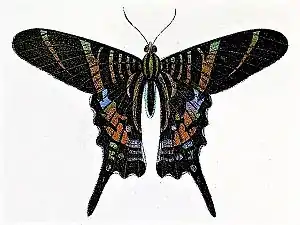 |
Arachnids
| Common name/scientific name | Extinction date | Range | Image |
|---|---|---|---|
| Caribbean monk seal nasal mite Halarachne americana |
1952?[64] | Caribbean Sea | |
| Tityus exstinctus | 1890[65] | Martinique |  |
Molluscs
| Common name/scientific name | Range |
|---|---|
| Amphicyclotulus guadeloupensis | Guadeloupe[66] |
| Incerticyclus cinereus | Martinique[67] |
| Incerticyclus martinicensis | Martinique[68] |
| Oleacina guadeloupensis | Guadeloupe[69] |
| Common name/scientific name | Extinction date | Range |
|---|---|---|
| Pleurodonte desidens | 1834[70] | Martinique |
See also
References
- Cooke, S. B., Rosenberger, A. L., & Turvey, S. (2011). An extinct monkey from Haiti and the origins of the Greater Antillean primates. Proceedings of the National Academy of Sciences, 108(7), 2699–2704.
- Turvey, Sam (2009). Holocene extinctions. Oxford University Press. ISBN 978-0-19-953509-5. Retrieved 29 February 2012.
- MacPhee, R. D. E. (2009). Insulae infortunatae: establishing a chronology for Late Quaternary mammal extinctions in the West Indies. In American megafaunal extinctions at the end of the Pleistocene (pp. 169–193). Springer, Dordrecht.
- Turvey, S.T; Oliver, J.R; Storde, Y.M Narganes; Rye, P (22 April 2007). "Late Holocene extinction of Puerto Rican native land mammals". Biology Letters. 3 (2): 193–6. doi:10.1098/rsbl.2006.0585. PMC 2375922. PMID 17251123.
- Morgan, Gary S., et al. "Late Quaternary fossil mammals from the Cayman Islands, West Indies." Bulletin of the American Museum of Natural History 2019.428 (2019): 1–82.
- MacPhee, R.D., Iturralde-Vinent, M.A., & Vázquez, O.J. (2007). Prehistoric sloth extinctions in Cuba: Implications of a new "last" appearance date. Caribbean Journal of Science, 43(1), 94–98.
- MacPhee, Ross DE, Clare Flemming, and Darrin P. Lunde. ""Last occurrence" of the Antillean insectivoran Nesophontes: new radiometric dates and their interpretation. American Museum novitates; no. 3261." (1999).
- Steadman, David W.; Martin, Paul S.; MacPhee, Ross D. E.; Jull, A. J. T.; McDonald, H. Gregory; Woods, Charles A.; Iturralde-Vinent, Manuel; Hodgins, Gregory W. L. (16 August 2005). "Asynchronous extinction of late Quaternary sloths on continents and islands". Proceedings of the National Academy of Sciences of the United States of America. 102 (33): 11763–8. Bibcode:2005PNAS..10211763S. doi:10.1073/pnas.0502777102. PMC 1187974. PMID 16085711.
- Steadman, D. W., Pregill, G. K., & Olson, S. L. (1984). Fossil vertebrates from Antigua, Lesser Antilles: evidence for late Holocene human-caused extinctions in the West Indies. Proceedings of the National Academy of Sciences, 81(14), 4448–4451.
- Orihuela, J., Orozco, L. P., Licourt, J. L. Á., Muñoz, R. A. V., & Barani, C. S. (2020). Late Holocene land vertebrate fauna from Cueva de los Nesofontes, Western Cuba: stratigraphy, last appearance dates, diversity and paleoecology. bioRxiv.
- Cooke, S. B., Mychajliw, A. M., Southon, J., & MacPhee, R. D. (2017). The extinction of Xenothrix mcgregori, Jamaica's last monkey. Journal of Mammalogy, 98(4), 937–949.
- Orihuela, J. (2010). Late Holocene fauna from a cave deposit in Western Cuba: post-Columbian occurrence of the vampire bat Desmodus rotundus (Phyllostomidae: Desmodontinae). Caribbean Journal of Science, 46(2–3), 297–312.
- Turvey, S.; Helgen, K. (2016). "Boromys offella". IUCN Red List of Threatened Species. 2016: e.T2885A22206052. doi:10.2305/IUCN.UK.2016-2.RLTS.T2885A22206052.en. Retrieved 8 August 2021.
- Turvey, S.; Helgen, K. (2016). "Boromys torrei". IUCN Red List of Threatened Species. 2016: e.T2886A22206099. doi:10.2305/IUCN.UK.2016-2.RLTS.T2886A22206099.en. Retrieved 8 August 2021.
- Haynes, Gary (2009). American megafaunal extinctions at the end of the Pleistocene. Springer. ISBN 978-1-4020-8792-9. Retrieved 28 February 2012.
- Turvey, S.T.; Helgen, K. (2018). "Geocapromys columbianus". IUCN Red List of Threatened Species. 2018: e.T9004A22186798. doi:10.2305/IUCN.UK.2018-2.RLTS.T9004A22186798.en. Retrieved 8 August 2021.
- Turvey, S.T.; Helgen, K. (2018). "Geocapromys thoracatus". IUCN Red List of Threatened Species. 2018: e.T9003A22186735. doi:10.2305/IUCN.UK.2018-2.RLTS.T9003A22186735.en. Retrieved 8 August 2021.
- Turvey, S.T.; Helgen, K. (2018). "Hexolobodon phenax". IUCN Red List of Threatened Species. 2018: e.T10034A22187167. doi:10.2305/IUCN.UK.2018-2.RLTS.T10034A22187167.en. Retrieved 8 August 2021.
- Turvey, S.T.; Helgen, K. (2018). "Isolobodon montanus". IUCN Red List of Threatened Species. 2018: e.T10859A22186956. doi:10.2305/IUCN.UK.2018-2.RLTS.T10859A22186956.en. Retrieved 8 August 2021.
- Turvey, S.T.; Dávalos, L. (2018). "Isolobodon portoricensis". IUCN Red List of Threatened Species. 2018: e.T10860A22186876. doi:10.2305/IUCN.UK.2018-2.RLTS.T10860A22186876.en. Retrieved 8 August 2021.
- Turvey, S.T.; Helgen, K. (2017). "Megalomys desmarestii". IUCN Red List of Threatened Species. 2017: e.T12980A22377057. doi:10.2305/IUCN.UK.2017-3.RLTS.T12980A22377057.en. Retrieved 8 August 2021.
- Turvey, S.T.; Helgen, K. (2017). "Megalomys luciae". IUCN Red List of Threatened Species. 2017: e.T12981A22377126. doi:10.2305/IUCN.UK.2017-3.RLTS.T12981A22377126.en. Retrieved 8 August 2021.
- Westermann, J.H. (1953) Nature preservation in the Caribbean: A review of literature of the destruction and preservation of flora and fauna in the Caribbean area. Foundation for Scientific Research in Surinam and the Netherlands Antilles, 106 pages.
- Lowry, L. (2015). "Neomonachus tropicalis". IUCN Red List of Threatened Species. 2015: e.T13655A45228171. doi:10.2305/IUCN.UK.2015-2.RLTS.T13655A45228171.en. Retrieved 8 August 2021.
- Turvey, S.T.; Dávalos, L. (2019). "Oligoryzomys victus". IUCN Red List of Threatened Species. 2019: e.T15255A22357957. doi:10.2305/IUCN.UK.2019-1.RLTS.T15255A22357957.en. Retrieved 8 August 2021.
- Turvey, S.T.; Helgen, K. (2017). "Oryzomys antillarum". IUCN Red List of Threatened Species. 2017: e.T136540A22388029. doi:10.2305/IUCN.UK.2017-3.RLTS.T136540A22388029.en. Retrieved 18 November 2021.
- Turvey, S.T.; Collen, B. (2011). "Pennatomys nivalis". IUCN Red List of Threatened Species. 2011: e.T199838A9129524. doi:10.2305/IUCN.UK.2011-2.RLTS.T199838A9129524.en. Retrieved 8 August 2021.
- Turvey, S.T.; Helgen, K. (2018). "Plagiodontia ipnaeum". IUCN Red List of Threatened Species. 2018: e.T17462A22187847. doi:10.2305/IUCN.UK.2018-2.RLTS.T17462A22187847.en. Retrieved 8 August 2021.
- Turvey, S.T.; Helgen, K. (2018). "Solenodon marcanoi". IUCN Red List of Threatened Species. 2018: e.T20322A22327069. doi:10.2305/IUCN.UK.2018-2.RLTS.T20322A22327069.en. Retrieved 8 August 2021.
- Young, R.; Kennerley, R.; Turvey, S.T.; Borotto-Páez, R. (2020) [amended version of 2018 assessment]. "Mesocapromys nanus". IUCN Red List of Threatened Species. 2020: e.T13217A166518354. doi:10.2305/IUCN.UK.2020-1.RLTS.T13217A166518354.en. Retrieved 8 August 2021.
- Kennerley, R.; Turvey, S.T.; Young, R.; Borotto-Páez, R. (2019). "Mesocapromys sanfelipensis". IUCN Red List of Threatened Species. 2019: e.T13218A22186444. doi:10.2305/IUCN.UK.2019-1.RLTS.T13218A22186444.en. Retrieved 8 August 2021.
- Orihuela, J. (2019). An annotated list of Late Quaternary extinct birds of Cuba. Ornitología Neotropical, 30, 57–67.
- Wetmore, Alexander (1937-01-01). "Título en español". The Journal of Agriculture of the University of Puerto Rico (in Spanish). 21 (1): 5–16. doi:10.46429/jaupr.v21i1.14340. ISSN 2308-1759.
- Oswald, J. A., Allen, J. M., Witt, K. E., Folk, R. A., Albury, N. A., Steadman, D. W., & Guralnick, R. P. (2019). Ancient DNA from a 2,500-year-old Caribbean fossil places an extinct bird (Caracara creightoni) in a phylogenetic context. Molecular phylogenetics and evolution, 140, 106576.
- Hume, J.P. (2017) Extinct Birds. Bloomsbury Publishing, 560 pages.
- Oswald, J. A., Terrill, R. S., Stucky, B. J., LeFebvre, M. J., Steadman, D. W., Guralnick, R. P., & Allen, J. M. (2021). Ancient DNA from the extinct Haitian cave-rail (Nesotrochis steganinos) suggests a biogeographic connection between the Caribbean and Old World. Biology letters, 17(3), 20200760.
- Steadman, D. W., & Takano, O. M. (2013). A late-Holocene bird community from Hispaniola: refining the chronology of vertebrate extinction in the West Indies. The Holocene, 23(7), 936–944.
- BirdLife International (2016). "Amazona martinicana". IUCN Red List of Threatened Species. 2016: e.T22728705A94994181. doi:10.2305/IUCN.UK.2016-3.RLTS.T22728705A94994181.en. Retrieved 18 November 2021.
- BirdLife International (2016). "Amazona violacea". IUCN Red List of Threatened Species. 2016: e.T22728701A94994037. doi:10.2305/IUCN.UK.2016-3.RLTS.T22728701A94994037.en. Retrieved 18 November 2021.
- BirdLife International. (2016). Athene cunicularia. The IUCN Red List of Threatened Species 2016. doi:10.2305/IUCN.UK.2016-3.RLTS.T22689353A93227732.en
- BirdLife International (2017). "Bermuteo avivorus". IUCN Red List of Threatened Species. 2017: e.T62183030A119208276. doi:10.2305/IUCN.UK.2017-3.RLTS.T62183030A119208276.en. Retrieved 13 November 2021.
- Oswald, J. A., & Steadman, D. W. (2018). The late Quaternary bird community of New Providence, Bahamas. The Auk: Ornithological Advances, 135(2), 359–377.
- BirdLife International (2020). "Campephilus principalis". IUCN Red List of Threatened Species. 2020: e.T22681425A182588014. Retrieved 24 December 2020.
- BirdLife International (2017). "Nyctanassa carcinocatactes". IUCN Red List of Threatened Species. 2017: e.T62286255A119207935. doi:10.2305/IUCN.UK.2017-3.RLTS.T62286255A119207935.en. Retrieved 13 January 2018.
- BirdLife International (2016). "Chlorostilbon bracei". IUCN Red List of Threatened Species. 2016: e.T22687333A93148138. doi:10.2305/IUCN.UK.2016-3.RLTS.T22687333A93148138.en. Retrieved 18 November 2021.
- BirdLife International (2016). "Chlorostilbon elegans". IUCN Red List of Threatened Species. 2016: e.T22728709A94994346. doi:10.2305/IUCN.UK.2016-3.RLTS.T22728709A94994346.en. Retrieved 18 November 2021.
- BirdLife International (2018). "Turdus ravidus". IUCN Red List of Threatened Species. 2018: e.T22708835A129654803. doi:10.2305/IUCN.UK.2018-2.RLTS.T22708835A129654803.en. Retrieved 18 November 2021.
- BirdLife International (2020). "Leucopeza semperi". IUCN Red List of Threatened Species. 2020: e.T22721873A180049729. doi:10.2305/IUCN.UK.2020-3.RLTS.T22721873A180049729.en. Retrieved 18 November 2021.
- BirdLife International. (2020). "Siphonorhis americana". IUCN Red List of Threatened Species. 2020: e.T22689738A178420953. doi:10.2305/IUCN.UK.2020-3.RLTS.T22689738A178420953.en. Retrieved 8 August 2021.
- "Bachman's Warbler". South Florida Multi-species Recovery Plan (PDF). US Fish and Wildlife Service, Southeast Region. 1999. pp. 445–454.
- Kehlmaier, C., Barlow, A., Hastings, A. K., Vamberger, M., Paijmans, J. L., Steadman, D. W., ... & Fritz, U. (2017). Tropical ancient DNA reveals relationships of the extinct Bahamian giant tortoise Chelonoidis alburyorum. Proceedings of the Royal Society B: Biological Sciences, 284(1846), 20162235.
- Conservation Biology of Freshwater Turtles and Tortoises: A Compilation Project of the IUCN/SSC Tortoise and Freshwater Turtle Specialist Group. A.G.J. Rhodin, P.C.H. Pritchard, P.P. van Dijk, R.A. Saumure, K.A. Buhlmann, J.B. Iverson, and R.A. Mittermeier, Eds. Chelonian Research Monographs (ISSN 1088-7105) No. 5, doi:10.3854/crm.5.000e.fossil.checklist.v1.2015
- Platenberg, R.; Powell, R. (2017) [errata version of 2016 assessment]. "Borikenophis sanctaecrucis". IUCN Red List of Threatened Species. 2016: e.T40791A115177079. doi:10.2305/IUCN.UK.2016-3.RLTS.T40791A71740001.en. Retrieved 8 August 2021.
- Powell, R. (2011). "Cyclura onchiopsis". IUCN Red List of Threatened Species. 2011: e.T173001A6955940. doi:10.2305/IUCN.UK.2011-1.RLTS.T173001A6955940.en. Retrieved 8 August 2021.
- Inchaustegui, S.; Landestoy, M.; Powell, R. (2017) [errata version of 2016 assessment]. "Leiocephalus eremitus". IUCN Red List of Threatened Species. 2016: e.T11388A115102107. doi:10.2305/IUCN.UK.2016-3.RLTS.T11388A71739619.en. Retrieved 8 August 2021.
- Powell, R. (2017) [errata version of 2016 assessment]. "Leiocephalus herminieri". IUCN Red List of Threatened Species. 2016: e.T11389A115102240. doi:10.2305/IUCN.UK.2016-3.RLTS.T11389A71739645.en. Retrieved 8 August 2021.
- Dewynter, M. (2017) [amended version of 2016 assessment]. "Pholidoscelis cineraceus". IUCN Red List of Threatened Species. 2017: e.T1119A121639617. doi:10.2305/IUCN.UK.2017-3.RLTS.T1119A121639617.en. Retrieved 8 August 2021.
- Platenberg, R.; de Queiroz, K.; Mahler, D.L. (2020). "Anolis roosevelti". IUCN Red List of Threatened Species. 2020: e.T1319A18967413. doi:10.2305/IUCN.UK.2020-3.RLTS.T1319A18967413.en. Retrieved 18 November 2021.
- Wilson, B.S.; Hedges, B. (2020) [amended version of 2017 assessment]. "Celestus occiduus". IUCN Red List of Threatened Species. 2020: e.T4097A181348221. doi:10.2305/IUCN.UK.2020-3.RLTS.T4097A181348221.en. Retrieved 8 August 2021.
- Landestoy, M.; Inchaustegui, S.; Powell, R.; Henderson, R.W. (2021). "Tropidophis bucculentus". IUCN Red List of Threatened Species. 2021: e.T75606372A75607979. doi:10.2305/IUCN.UK.2021-2.RLTS.T75606372A75607979.en. Retrieved 13 May 2022.
- IUCN SSC Amphibian Specialist Group. (2021). "Eleutherodactylus jasperi". IUCN Red List of Threatened Species. 2021: e.T7142A172793582. doi:10.2305/IUCN.UK.2021-1.RLTS.T7142A172793582.en. Retrieved 8 August 2021.
- IUCN SSC Amphibian Specialist Group. (2021). "Eleutherodactylus karlschmidti". IUCN Red List of Threatened Species. 2021: e.T7146A172793731. doi:10.2305/IUCN.UK.2021-1.RLTS.T7146A172793731.en. Retrieved 8 August 2021.
- Flach, T. (2017) Endangered. Abrams, 336 pages.
- Seal, West Indian Monk. Published 13 July 2004 by the American Society of Mammalogists.
- Lourenço, W. R. (1995). The remarkable discovery of a new and extinct species of Tityus from Martinique in Lesser Antilles (Chelicerata, Scorpiones, Buthidae). Anales de la Universidad Nacional Autónoma de México, Serie Zoológica, 66(1), 27–32.
- Bouchet, P. (1996). "Amphicyclotulus guadeloupensis". IUCN Red List of Threatened Species. 1996: e.T1164A3300027. doi:10.2305/IUCN.UK.1996.RLTS.T1164A3300027.en. Retrieved 13 November 2021.
- Bouchet, P. (1996). "Incerticyclus cinereus". IUCN Red List of Threatened Species. 1996: e.T10815A3218955. doi:10.2305/IUCN.UK.1996.RLTS.T10815A3218955.en. Retrieved 13 November 2021.
- Bouchet, P. (1996). "Incerticyclus cinereus". IUCN Red List of Threatened Species. 1996: e.T10815A3218955. doi:10.2305/IUCN.UK.1996.RLTS.T10815A3218955.en. Retrieved 13 November 2021.
- Bouchet, P. (1996). "Oleacina guadeloupensis". IUCN Red List of Threatened Species. 1996: e.T15191A4501196. doi:10.2305/IUCN.UK.1996.RLTS.T15191A4501196.en. Retrieved 13 November 2021.
- Bouchet, P. (2000). "Pleurodonte desidens". IUCN Red List of Threatened Species. 2000: e.T17708A7352120. doi:10.2305/IUCN.UK.2000.RLTS.T17708A7352120.en. Retrieved 13 November 2021.
This article is issued from Wikipedia. The text is licensed under Creative Commons - Attribution - Sharealike. Additional terms may apply for the media files.